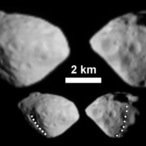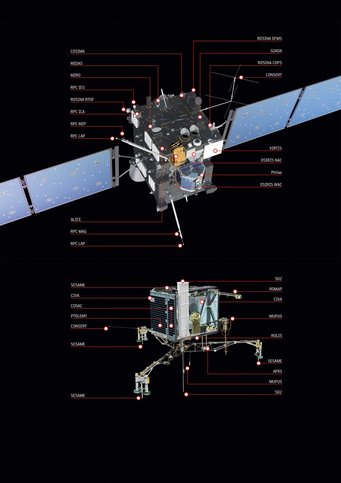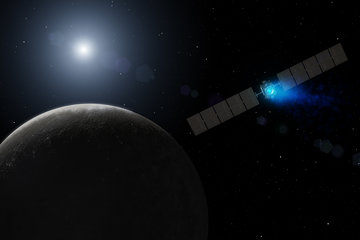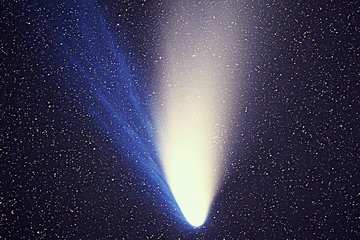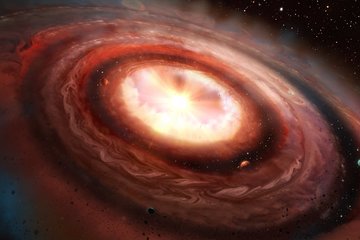Rendezvous with a chunk of primeval rock
Although the comparison with the manned Moon landing may appear somewhat exaggerated, Rosetta is undoubtedly one of space travel’s most daring enterprises.
Although the comparison with the manned Moon landing may appear somewhat exaggerated, Rosetta is undoubtedly one of space travel’s most daring enterprises: For the first time in history, a probe is accompanying a comet on its orbit around the sun, and in the middle of November it will set down the Philae lander on its surface. Scientists from the Max Planck Institute for Solar System Research in Göttingen have front row seats for the evaluation of the images and data from the comet named 67P/Churyumov-Gerasimenko.
Text: Helmut Hornung
MARCH 2, 2004; 8:17 a.m. CET

Comet experts discuss the latest images from Rosetta: Martin Hilchenbach, Holger Sierks, Paul Hartogh and Hermann Böhnhardt (from left) at the Max Planck Institute for Solar System Research.
Darkness still shrouds the Kourou spaceport in French Guiana as a type Ariane 5G+ rocket shoots up into the cloudy sky leaving a fiery trail in its wake. On board a freight that is intended to shed more light upon the origins of the solar system: Rosetta. The probe itself is slightly larger than a Smart car. Its two long wings with solar panels for the energy supply give it the appearance of a strange insect. Aboard Rosetta, in addition to the SREM detector for detecting high-energy particle radiation, are eleven instruments and a box as large as a refrigerator: Philae. It is to perform the trick of landing on the nucleus of a comet and conduct measurements there over several months with the aid of ten scientific devices.
Rosetta’s history goes back to 1984. At that time, the European Space Agency ESA decided to undertake a mission to the nucleus of a comet, initially in partnership with NASA. After budget cuts forced the Americans to withdraw, the Europeans continued the plan alone. In Germany, the German Aerospace Center and the Max Planck Institute for Aeronomics (since 2004: Solar System Research) were initially the major players in the project; the latter made a significant contribution to the development and construction of the lander, among other things.
On January 13, 2003 Rosetta and Philae were due to lift off to the Wirtanen comet. But a rocket from the Ariane 5 series, like the one which was to transport the ambitious mission, had managed to perform a spectacularly unsuccessful lift off. The European space program was halted temporarily, the start of the comet scout postponed by more than a year. Moreover, a new destination had to be found. The choice was ultimately 67P/Churyumov-Gerasimenko. Two scientists, Churyumov and Gerasimenko, at the Institute for Astrophysics in Alma-Ata/Kazakhstan, had discovered the celestial body as a tiny star on a photographic plate in fall 1969.
In the past, the gravitational field of the planet Jupiter had influenced the trajectory of “Chury.” Before 1840 it orbited the sun at a considerable distance, and the lack of heat meant it had not been able to develop any cometary activities up to this point. Meaning: The nucleus should still be relatively fresh and pristine – which researchers see as a benefit. In its present orbit the comet approaches the sun to within a distance of around 193 million kilometres (Earth’s distance to the sun: 150 million kilometres) every six years and 203 days.

SEPTEMBER 7, 2008; 10:14 p.m. CEST
Signals from the depth of space appear on the screens in the ESA Control Centre in Darmstadt. The flight engineers immediately forward them on to the Max Planck Institute for Solar System Research. Although it is the middle of the night, 14 scientists here filter the first images from the raw data. These show a rock with an elongated shape which tapers to a point at one end; countless craters cover its surface, a particularly large crater two kilometres in diameter is located at the North Pole. The subject is around 360 million kilometres from Earth – and shows the Šteins asteroid. Rosetta passed by it on September 5, 2008 at a distance of 800 kilometres.
Although the OSIRIS telecamera switches into safety mode nine minutes before the rendezvous and only the wide-angle camera is working, the researchers are satisfied with their instruments. OSIRIS is the abbreviation for Optical, Spectroscopic and Infrared Remote Imaging System. Two cameras constructed as mirror systems take images in the ultraviolet, visible and infrared spectral ranges. The light-sensitive CCD detectors are made up of 2048 by 2048 pixels; each of these pixels measures 13.5 micrometres (one-thousandth of a millimetre).
Before its rendezvous with Šteins, Rosetta had flown past Earth on March 4, 2005 at a distance of only 1955 kilometres. It was even possible back then to see the probe with binoculars. On February 25, 2007 Rosetta passed Mars; on November 13 of the same year it again gained momentum with the aid of our planet. After the rendezvous with Šteins, it executed another Earth fly-by on November 13, 2009.
Why this extremely complicated trajectory? A direct flight from Earth to Churyumov-Gerasimenko would have required enormous quantities of fuel. During the so-called swing-by manoeuvres on tortuous paths, Rosetta gained the energy it needed from the gravitational fields of the planets free of charge, as it were. During each of the three Earth swing-bys, the speed of the vehicle increased by around 20 000 kilometres per hour.
JULY 10, 2010; 6 p.m. CEST

The pace is infernal: Rosetta is travelling at no less than 54 000 kilometres per hour as it points its camera eyes at the asteroid Lutetia. This cosmic potato – its longitudinal dimension of around 126 kilometres making it significantly larger than Šteins – has a varied landscape with mountains, large numbers of large and small craters, scattered rocks and parallel grooves. The surface of the celestial object seems to be covered by a thick layer of fine-grained, loose material (regolith).
With 3.5 grams per cubic centimetre, Lutetia has an unusually high density. From the spectra, specialists conclude that it has a composition comparable to those of meteorites belonging to the carbonaceous chondrites, which have a high carbon content; but there are also similarities with the so-called enstatite chondrites, which contain the mineral enstatite.
Rosetta cannot solve the mystery of which family Lutetia belongs to. The scientists are certain of one thing, however: “This is a completely new world that no one has ever seen before,” says Holger Sierks from the Max Planck Institute for Solar System Research, head of the OSIRIS team. The instrument provides images with a detail resolution of 60 meters. Some images even provide indications of a landslide within a crater. All in all, a successful dress rehearsal for the meeting with Churyumov-Gerasimenko.
JUNE 8, 2011
After the engineers and technicians had installed upgraded software for the central computer in December 2010, they switched it off. Some months later and slightly earlier than planned, on June 8, 2011, they then put the complete spacecraft into a deep sleep. Rosetta now slowly rotates about its own axis for stabilization.
In October 2012, the probe reaches the point of its trajectory furthest from the sun; around 795 million kilometres separate it from the warming rays. At this enormous distance, even the 64 square meters of the solar sail generate only small amounts of power. This is nevertheless sufficient to keep the vehicle reasonably warm and a clock on board ticking.
JANUARY 20, 2014; 10:59 a.m. CET
An alarm clock rings in space. Its job is to bring Rosetta out of hibernation after 957 days. The probe is whizzing around in the depths of space, nearly 815 million kilometres from Earth. It is the beginning of anxious hours of waiting for the technicians, engineers and scientists in the European Space Operations Centre (ESOC) in Darmstadt.
Will Rosetta really wake up? If yes, the plan is as follows: The star sensors for the attitude and orbit control will slowly heat up to operating temperature, open their eyes and take their orientation from the sky. The steady rotation of the probe about its axis will gradually come to a halt, the parabolic dish 2.2 meters in diameter will align itself towards Earth and send the first sign of life.
JANUARY 20, 2014; 7:18 p.m. CET
Even though, owing to the huge distance, it takes a bit more than 45 minutes until the signal from Rosetta reaches Earth, is received by a dish in Goldstone/California and appears as a small line in an irregularly jagged green curve on the monitor in Darmstadt, some scientists had expected that this would take place around 6:30 p.m. on January 20, 2014. It is now already after 7 p.m. and Rosetta has been overdue for three-quarters of an hour.
The nervousness is increasing in the ESOC. All are looking up as if spell-bound towards a monitor. The clock in the control room stands at 7:18 p.m. when a line actually appears on the screen – first short, then slowly becoming longer. Two technicians at the consoles are the first to throw up their arms. The cheering starts. People hug each other. A glass breaks somewhere. Rosetta is awake! It is now setting off on the final stage of a more than ten-year journey.
MARCH 21, 2014

The picture looks as if it was taken by a well-equipped amateur astronomer. The magnificent globular cluster known as Messier 107 in the Serpent Bearer constellation shimmers slightly left of centre. Diagonally above M 107 there appears a weak spot of light, which a layperson could easily overlook. But for Holger Sierks it is something very special: “To finally have our destination within our sights after a ten-year trip through space is an indescribable feeling,” says the Max Planck researcher. The unassuming little star is none other than 67P/Churyumov-Gerasimenko, as seen through OSIRIS’ eyes.
The camera system on board Rosetta must operate to its performance limits. After all, more than five million kilometres separate space probe and comet from each other. This explains why the comet on the photos covers only a fraction of a pixel. What’s more, the celestial body glimmers like a very dim glimmer; a series of exposures from 60 to 300 seconds and additional image processing are required to make it visible at all.
While Rosetta and its instruments are slowly fully awakening, Churyumov-Gerasimenko is still in a sort of slumber. Typical behaviour for a comet. Just like all members of the Jupiter family, it spends most of its life in the icy depths of the planetary system at a similar distance from the sun, like the Jupiter gas giant. This is where countless bodies several kilometres in size whizz about as dead lumps of frozen gases, such as carbon dioxide, ice and rock.
In all probability, “Chury” and its peers have their origins in the so-called Kuiper Belt. This ring-like region at the very edge of our planetary system beyond Neptune’s orbit is more than 30-times more distant from the sun than Earth, and is populated with thousands of cosmic rocks. Under the influence of Neptune, the orbits of individual bodies gradually shift towards the other gas giants in the planetary system – right down to Jupiter.
“Despite this migration – and the collisions which possibly preceded it – comets in the Jupiter family are some of the purest material that has been preserved from the birth of the solar system more than 4.6 billion years ago,” says Ulrich Christensen, Director at the Max Planck Institute for Solar System Research. While the inner planets such as Mercury and Venus especially have undergone great changes as a result of the heat and the particle bombardment from the Sun and have lost volatile components, this material has been stored in an unadulterated state in the ice of the comets for billions of years.
If the cosmic vagabond moves nearer to the Sun on its orbit, its surface begins to warm up, water and frozen gases evaporate and entrain tiny dust particles. The comet becomes active: an atmosphere (coma) forms around its nucleus and finally it develops the characteristic tail.
This material is what Rosetta will investigate in more detail than ever before. “The space probe is a kind of laboratory which is operated onsite at the comet,” says Max Planck Researcher Martin Hilchenbach, head of the COSIMA team. COSIMA is one of the instruments which are intended to specifically coax some of the secrets out of the cometary dust. In the microscopic, cauliflower-shaped pores of carriers only a few millimetres in size, the dust catcher collects individual particles, which are first localized under a microscope before being bombarded with indium ions. The ions that are released from the surface of the dust particles in this process can be analysed further. “We can identify not only individual elements, but also organic molecules in particular,” says Hilchenbach.
APRIL 30, 2014

“Chury” is really a comet! At least the images taken by OSIRIS show a real coma. It stretches around 1300 kilometres into space and envelops the nucleus with gas and dust. The researchers are astonished by this cloud, because the comet is still more than 600 million kilometres from the Sun. However, the splendour does not last very long: photos from the beginning of June show 67P as a tiny star again with no activity whatsoever. The comet apparently woke up too early and immediately nodded off again.
OSIRIS reveals furthermore that the nucleus, which measures five by three kilometres, rotates about its axis once every 12.4 hours – 20 minutes shorter than determined previously from Earth. If this is not owing to a measurement error, something must have reduced the rotational time. Which proves once again: Comets are always good for a surprise.
JUNE 6, 2014
The comet is sweating. It is releasing a large glass of water every second, or more precisely: around 300 grams of water vapour. This was determined by an instrument called MIRO. The small radio telescope receives signals from a respectable 350 000 kilometres; this is now the separation between Rosetta and 67P.
MIRO analyses the microwave radiation which originates from the gas molecules. Water and other substances leave characteristic fingerprints on the light in this wavelength range. “The signals that water molecules leave in our measurement data can be detected particularly well,” says Paul Hartogh from the Max Planck Institute for Solar System Research, who supervised the development and construction of a subsystem of MIRO. The researcher is pleased with its sensitivity: It’s as if one were to discover the evaporation of a cup of hot tea on the Moon from Earth.
July 14, 2014
A rubber duck is orbiting in space! At least this is what images suggest which show Churyumov-Gerasimenko from a distance of less than 12 000 kilometres; on Earth, this would roughly correspond to the distance between Germany and Hawaii. The images from the middle of July prove that the nucleus of the comet consists of two clearly separated parts: a larger “body” on which a smaller “head” sits.
JULY 21, 2014
The rubber duck has a collar. Rosetta is now only 5500 kilometres away and providing images with a resolution of 100 meters per pixel. The images clearly show that the “neck region” located between “head” and “body” appears much brighter. This is where an abyss some 1000 meters deep opens up, and where the camera discovers so-called jets – fountains of dust. The brightness of the band could be caused by differences in material, different grain sizes or topographic effects. It is still unclear how 67P got its duck-like shape. A few researchers speculate as to whether “head” and “body” were originally two separate objects.
JULY 25, 2014
The coma has appeared again. The images show an extensive cloud of dust around the nucleus. The diffuse cloud completely fills the camera’s field of view, an area measuring 150 by 150 kilometres. It appears to be only the inner region of the coma, in which the particle density is highest. The total structure should be significantly larger, but cannot be imaged by Rosetta from a distance of a mere 2500 kilometres. And so it seems that Churyumov-Gerasimenko – after a brief phase of activity in April – is finally fully awake.
AUGUST 6, 2014; 11:30 a.m. CEST
Arrived at last! Rosetta has travelled 6.4 billion kilometres. “After flying on the approach for nearly a decade it seems almost unreal to have actually arrived,” says Max Planck researcher Holger Sierks. Just before he made this statement, the European Control Centre in Darmstadt had received the signal that provided the relief. Rosetta had swivelled into pyramidal orbits around 67P, following a “triangular” orbit about the nucleus. The space probe initially approached the comet to within 100 kilometres; since the beginning of September it has been 50 kilometres and less.
Even shortly before the thrust manoeuvre on August 6, the spatial resolution of the images was 5.5 meters per pixel and thus surpassed all previous images of cometary nuclei. In addition to stark differences in brightness on the surface, sharp-angled cliffs, mountains and deep escarpments now appear. Expanses of smooth surfaces and round hills can also be seen.
A landscape of strange beauty, partially formed by the comet’s activity. During earlier approaches to the Sun, volatile substances from its surface vaporized and entrained jets of dust. If these dust particles are too heavy or too slow to leave the gravitational field of the comet, they fall back to the surface, where they collect in places and create different geological formations.
THE ONBOARD INSTRUMENTS... of Rosetta OSIRIS* camera system with telecamera and wide-angle camera
ALICE UV spectrometer
VIRTIS spectrometer for the visible and infrared
MIRO* microwave spectrometer
RSI radiowave experiment
CONSERT* radar tomograph
ROSINA* neutral gas and ion mass spectrometer
COSIMA* dust mass spectrometer
MIDAS dust microscope
GIADA dust analyzer
RPC plasma analyzer ...of Philae SD2 drills and sampler
COSAC* gas chromatograph, mass spectrometer Ptolemy gas chromatograph, mass spectrometer
APXS** alpha X-ray spectrometer
ROLIS camera system
CIVA camera system, infrared spectrometer, microscope
MUPUS penetrator, thermal probe, radiometer
SESAME* acoustic seismometer, dust monitor
CONSERT* radio wave experiment
ROMAP*** magnetometer, plasma monitor
AUGUST 25, 2014

As level as possible, not too much shade, not too much sun − and scientifically interesting: The region on the nucleus of 67P/Churyumov-Gerasimenko where Philae will land must fulfil these conditions. Today, researchers and engineers announce five possible candidates: three of the potential landing sites are on the “head,” the other two on the larger “body” of the comet. They are given the designations A, B, C, I and J.
“The most important criterion was of course that Philae can reach the areas in the first place,” says Hermann Böhnhardt from the Max Planck Institute for Solar System Research, scientific head of the lander mission. This does not apply to all regions, of course. Even if one takes into account all the conceivable velocities, trajectories and orientations of the space probe at the moment Philae undocks, as well as the different possible detaching speeds of the lander itself, the map of the comet still has no-go areas.
And equally important: From the landing site, there must be regular radio contact to the space probe in order to exchange operational commands and data. A surface which is as level as possible should guarantee a safe landing. Moreover, six hours of sunlight are necessary every day for at least six months to charge Philae’s solar batteries. However, the Sun must not shine for too long, either, otherwise the station could overheat.
SEPTEMBER 10, 2014
Mapping a comet. The images transmitted by OSIRIS achieve a resolution of 75 centimetres per pixel. With areas characterized by steep cliffs, depressions, craters, scattered rocks and parallel grooves, 67P exhibits many different landscapes. Some of these regions appear quiet; others were apparently formed by the activity of the comet.
The scientists combine the various expansive landscapes into a map – and puzzle over how it should look: “So far, nobody really understands how the morphological differences that we see have formed,” says Max Planck researcher Holger Sierks.
SEPTEMBER 16, 2014

J comes out on top. Although the images there show a quite rugged terrain, almost in the centre of the “head” of the comet, computations show that the chances for a landing are good. The researchers and technicians take into account the topography of the area and the mechanical characteristics of Philae’s landing gear. The spot on which Philae touches down can be determined to within only 500 meters or so.
“This means we do not need one perfect spot, but a complete region where as many landing scenarios as possible have a happy end,” says Hermann Böhnhardt. This area is dotted with comparably few large rocks which could present a danger to Philae, for example. In addition, measurements indicate that organic material is present here. Finally, CONSERT should find very acceptable conditions for its radio observations at the landing site selected.
CONSERT is the only experiment of the Rosetta mission which is part of the orbiter and part of the lander. It is to use radio waves to investigate the inner structure of the comet’s nucleus. A radio signal will be transmitted from the space probe through the nucleus to the lander and back. The shape of the nucleus and the flight path of the orbiter mean that not every spot on the surface of 67P is equally suited to penetrate the whole of the comet’s nucleus. Landing site J is one of the best sites for this task. On 14 October 2014, J is confirmed. On October 14, 2014. It is named "Agilkia". One of the greatest adventures of space travel can begin.
THE ROSETTA STONE AND THE ISLAND IN THE NILE
1822, Egyptologist Jean-François Champollion (1790 to 1832) succeeded in deciphering hieroglyphics. He did this by analysing the Rosetta Stone, which bears the same text in three languages: Hieroglyphics, Demotic, Ancient Greek. Taking its lead from this stone, the Rosetta mission aims to help solve the mystery of the comets and the early evolution of the solar system. Before the start, ESA announced a competition to find a name for the lander. Philae came out on top – named after an island in the Nile on which a temple and precincts once stood. One of the remaining obelisks bears an inscription in Greek and Egyptian and was used to help decipher hieroglyphics.
TO THE POINT
Rosetta is the first mission in the history of space travel planned to accompany a comet on its orbit around the Sun for several months and put down the Philae lander on its nucleus in the middle of November 2014.
Rosetta has already been travelling through space for more than a decade. In August 2014 the probe reached its destination, the comet 67P/Churyumov-Gerasimenko.
Rosetta is the first mission in the history of space travel planned to accompany a comet on its orbit around the Sun for several months and put down the Philae lander on its nucleus in the middle of November 2014. Churyumov-Gerasimenko has an elongated, two-part shape. It reminds some researchers of a rubber duck, with “body” and “head” connected by a bright “collar”. The nucleus measures approximately five by three kilometres. With steep cliffs, depressions, craters, scattered rocks and parallel grooves, 67P exhibits many different landscapes.


